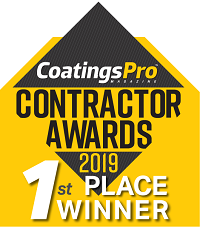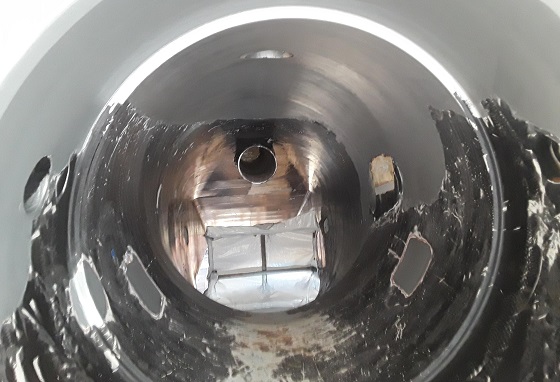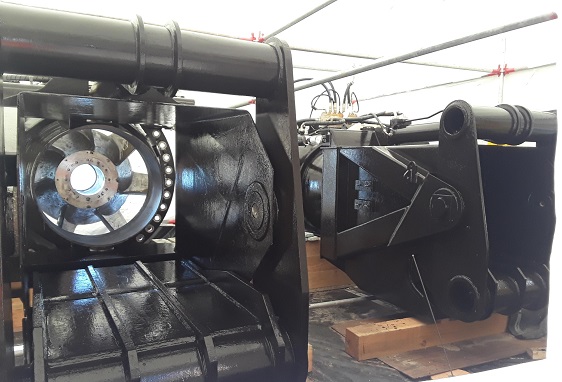At a BAE Systems shipyard on San Diego Bay sat the USS Omaha (LCS 12), an active duty littoral combat ship belonging to the U.S. Navy. Such vessels are kept in dry dock for about six to nine months so that routine maintenance checks and structural repairs can be performed.
 A check-up of the USS Omaha during the summer of 2018 revealed failed coatings on the vessel’s propulsion system. Before repairs could be made, the 9,000 square foot (836.1 m2) system first had to be disassembled by the vessel’s manufacturer, Austal USA. The failed coatings, along with barnacles and other marine growth, would then be removed from the system’s parts, followed by the application of antifouling coatings. What’s more, all of the work had to meet strict Navy guidelines. But if there was one company qualified to handle the project and location, it was nearby contractor Prime Time Coatings, Inc.
A check-up of the USS Omaha during the summer of 2018 revealed failed coatings on the vessel’s propulsion system. Before repairs could be made, the 9,000 square foot (836.1 m2) system first had to be disassembled by the vessel’s manufacturer, Austal USA. The failed coatings, along with barnacles and other marine growth, would then be removed from the system’s parts, followed by the application of antifouling coatings. What’s more, all of the work had to meet strict Navy guidelines. But if there was one company qualified to handle the project and location, it was nearby contractor Prime Time Coatings, Inc.
Following Protocol
Based in National City, Calif., just outside San Diego, Prime Time Coatings is a Department of Defense painting contractor whose owner and president, Johnny M. Sanchez, has helped provide coatings for the maritime sector since he was 19 years old. Having worked in the industry for about 25 years, Sanchez is familiar with the challenges that come with preserving a vessel like the USS Omaha. “Navy vessels sit in saltwater, which is one of the most corrosive environments on planet Earth. They’re under constant maintenance, especially when it comes to coatings,” he said.
Almost all of the preservation projects undertaken by Prime Time Coatings are for naval vessels, so Sanchez knew the procedure for winning the USS Omaha contract. He submitted a request for quote (RFQ) document specifying the money, manhours, and materials needed to complete the project. The Navy received the RFQ and responded with a best and final offer (BAFO) proposal that Sanchez used as the basis for a revised quote, which the Navy ultimately accepted. Sanchez said that the Navy tends to select BAFOs with the lowest bids, and Prime Time Coatings had already demonstrated an ability to follow the Navy’s periods of performance guidelines.
A Turnkey Operation
On August 20, 2018, Prime Time Coatings sent a 10-person crew led by project manager Shawn Tarango to the BAE Systems shipyard. Because the USS Omaha would only be dry docked for a limited period, time was of the essence. “There was no tomorrow or another time — the ship had to leave to rejoin the fleet, so the date we were given was the time it had to be completed,” said Tarango.
By the time Tarango’s crew had arrived, Austal engineers had already disassembled the propulsion system. Due to the project’s proximity to the bay, the crew took special safety and environmental precautions. They set up a berm to store the system’s components, which consisted of four aluminum jettavators and tunnels, as well as four stainless steel shafts. After these large components were laid out on the berm by crane, the crew erected 30-foot-tall (9.1 m) scaffolding around them. After clearing a government hold point, the scaffolding was sold to the Navy. The crew passed another hold point when it covered the components with a 10-mil (254.0 microns) plastic sheet that provided 100-percent containment and kept away moisture.

Prime Time Coatings had to meet the requirements of Naval Sea Systems Command (NAVSEA) Standard Item 009-32, Cleaning and Painting Requirements, which is the Navy’s official document for cleaning, surface preparation, and painting specifications for surface ships and submarines. Using NAVSEA 009-32 as his guide, Sanchez created a coating application process (CAP) sheet, which matched coatings from the document’s qualified products list to specific areas of the USS Omaha. The CAP sheet called for the use of the Society for Protective Coatings (SSPC)-Surface Preparation (SP) 1, a surface prep standard for the removal of all visible oil, grease, soil, and other soluble contaminants from steel surfaces.
Once the crew’s SSPC-SP1 surface prep passed the Navy’s cleanliness hold point, the next step was to hydroblast the propulsion system parts to remove both sea waste and the failed coatings. The crew achieved this by using a Jetstream pump system that releases a high-pressure water stream through a handheld wand attachment. This enabled crew members to point and shoot blasts of water with a maximum pressure of 7,000 psi (482.6 bar), in accordance with the SSPC-2J 2L/NACE WJ-2L standard for a very thorough cleaning by light flash rust. For personal protective equipment (PPE), they wore Wolverine steel-toed boots and knee highs to protect their feet and legs from the pressurized water, as well as 3M full-face respirators, hard hats with face shields, safety glasses, and ear plugs.
Hydroblasting the jettavators proved to be a delicate task, due to their intricate parts. “A lot of it was done with water, and they went in with sandpaper for the hand-detailed work inside the jettavators,” Sanchez explained. This allowed the crew to meet both the NACE No. 2/SSPC-SP10 standard for a near-white metal blast cleaning and the SSPC-SP11 standard for power tool cleaning to bare metal, and they were able to pass the Navy’s hold point.
So Many Coatings, So Little Time
For coatings application, the Prime Time Coatings crew used a 16-grit aluminum oxide sanding disk to achieve a surface profile average of 2 mils (50.8 microns) and to ensure the proper chloride concentration conductivity level of 30 µS/cm for paint application. Once this standard was met, the crew used Graco’s Premier 74:1 airless pump to apply a four-part coating system from AkzoNobel’s International Paint brand of marine coatings to the jettavators and tunnels. The first coat was a bronze-colored Intershield 300HS epoxy primer at 4–8 mils (101.6–203.2 microns); the second coat was another primer coat at the same thickness, but in an aluminum color; the third coat was a light-pink Intersleek 731 silicone elastomer tie coat applied at 3–6 mils (76.2–152.4 microns); and the fourth coat was a black antifouling paint, the Intersleek 1100SR fluoropolymer, as the topcoat at 5–8 mils (127.0–203.2 microns).
As for the shafts, NAVSEA specifications called for two coats of Sherwin-Williams Nova Plate UHS epoxy and two coats of the International Interspeed 5640 copper-free antifouling polymer paint applied with the same Graco pump at 4–8 mils (101.6–203.2 microns).
At each stage, the coatings had to pass a hold point before further work could commence. Because time was of the essence, the crew installed heaters and dehumidifiers to speed up the curing windows so that they could recoat in 12 hours — or at about half the usual curing time. PPE worn by the crew included hard hats, safety glasses, ear plugs, Tyvek suits, and reflective vests, along with 3M full-face respirators with National Institute for Occupational Safety and Health (NIOSH) approved filters.
In the Nick of Time
Sanchez said that the coatings system had to fully cure for at least 48 hours before the vessel could be released from dry dock. Once dryness was confirmed, the scaffolding and containment were removed, and components were craned back into place.
In late September, Tarango’s crew finished their preservation of the USS Omaha’s propulsion system. They worked each day of the 39-day project in two 12-hour shifts, with Tarango working an average of 10–16 hours. “We were able to stay as long as needed to get the job done,” Tarango said.
The hard work paid off, as the USS Omaha project won first place in the Specialty Projects category in CoatingsPro’s 2019 Contractor Awards program. Also, Austal USA was impressed that Prime Time Coatings was able to beat the scheduled deadline by three days, which is no small thing in the rigidly timed naval world. “If you can do it safely, with quality, and meet your deadlines, then you’re really hitting on all cylinders,” Sanchez said.
